The Chinese Presbyterian Church (CPC), currently located at 388-394 Crown Street, in Surry Hills, Sydney, is the oldest surviving Chinese church in Australia. It started life as the Presbyterian Chinese Mission when the Presbyterian Church of NSW appointed John Young Wai (周容威) in 1883 to encourage Chinese to attend the church. In its early days, services were held in Young Wai’s house on Nithsdale Street (1884) and later at the premises of a Chinese firm in Goulburn Street (1889), with 30-40 worshippers.
In order to attract more Chinese migrants, especially those from the working class, to attend the church, Young Wai travelled to market gardens to visit Chinese workers and started an evening service to meet their schedules. He also assisted Chinese migrants to adapt to their new lives in Australia. As the Chinese congregation grew bigger (with regular worshippers increased to 70-80 people at the Sunday evening services), in 1892 Young organised a music festival to raise money to build a new church. Of donations of around £600, £342 came from the Chinese community (Presbyterian Messenger in Kuo, 2013).
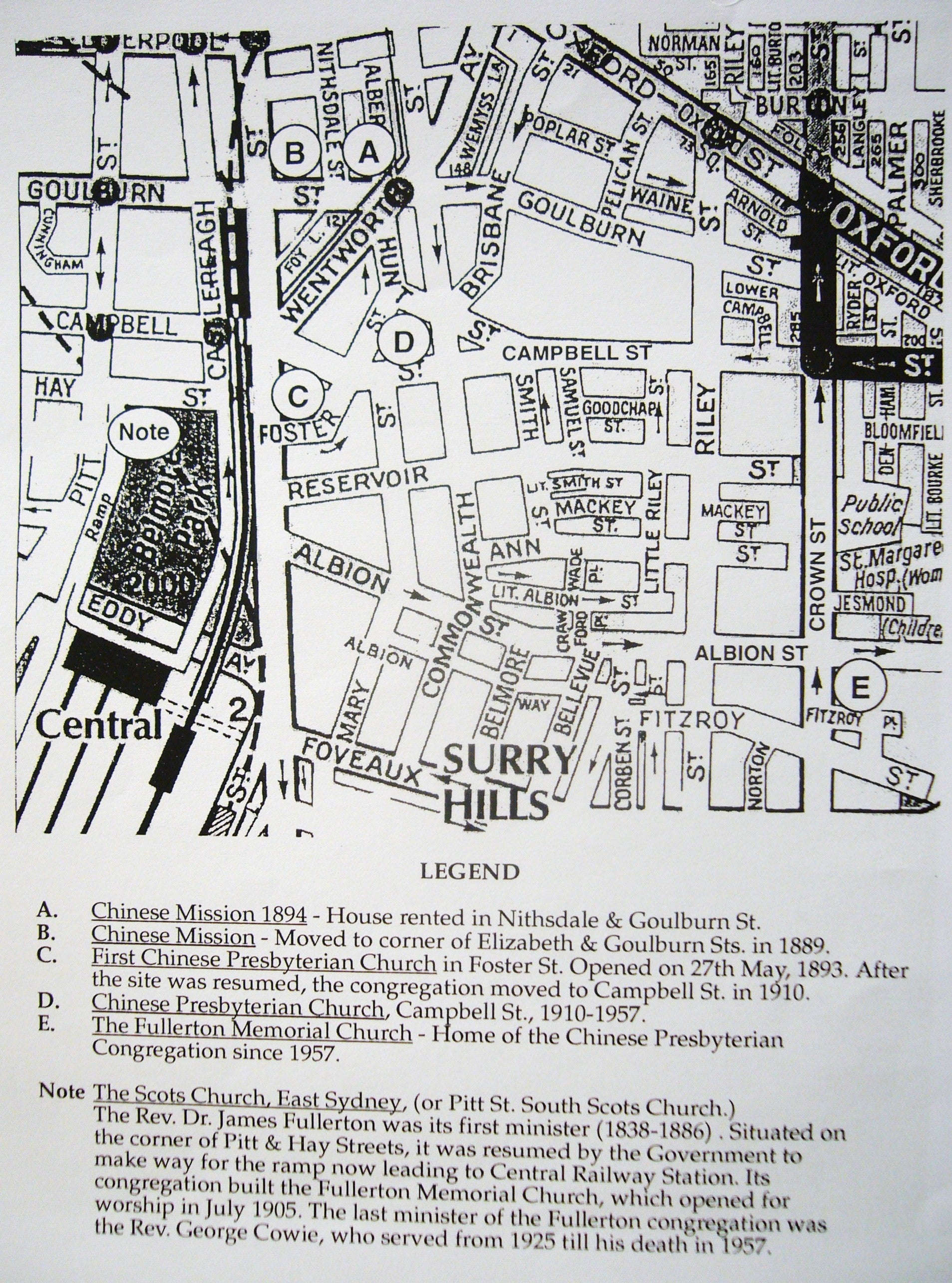
Locations of the Chinese Presbyterian Church (from 1884 to today) (courtesy of Howard Wilson)
In 1893, a new church was built and commenced operation in Foster Street, Surry Hills and Reverend John Young Wai became the first minister there. A night school was started to teach the English language to Chinese immigrants, which later became the largest teaching organisation for Chinese immigrants in the late 19th century (Kuo, 2013). The increasing number of Australian Chinese converting to Christianity, included young entrepreneurs such as Ying Piu Ma (马应彪), the founder of Wing Sang & Co. in 1890, who was known to have a close relationship with Reverend Young Wai. Other co-founders of Wing Sang & Co., George Bew (郭标) , James Hing Choy (蔡兴) and Wing Chan Ma (aka Mark Joe) (马永灿), were baptized at the church by Reverend Young Wai in 1894 (Photo 3). These men returned to Hong Kong and became directors of the Sincere Department Store in the first decade of the 20th century. James Lock Gock (郭乐), who started Wing On Fruit Store in 1898 and founded the Wing On department store chain in Hong Kong in 1907, was also a member of the CPC in Sydney.

News on the baptism of Hing Choy, George Bew and Joe Young Ma etc in 1894 (6 April 1894, The Presbyterian Messenger)(courtesy of Howard Wilson)

The congregation of the CPC church in 1905 (including James Hing Choy and George Bew, Wing Chan Ma, James Lock Gock) (courtesy of Howard Wilson)
The church on Foster Street was demolished after the Sydney Council resumed the land in 1910 as part of a slum clearance program. The church purchased a piece of land nearby at 108 Campbell Street and opened a new church there in 1910. A comparison of this new church with photos of the Foster Street one suggest that most of the sandstone blocks (and perhaps the bricks) from the old church were recycled into the new one. The CPC stayed in Campbell Street until 1957 when the congregation had outgrown the building’s capacity. The CPC moved to the existing Fullerton Memorial Church on the corner of Crown and Albion Streets, in Surry Hills, in the same year and remains there today. The CPC has become one of the largest congregations in the Presbyterian Church in Australia, and offers a Chinese language school for school children who are born in Australia.
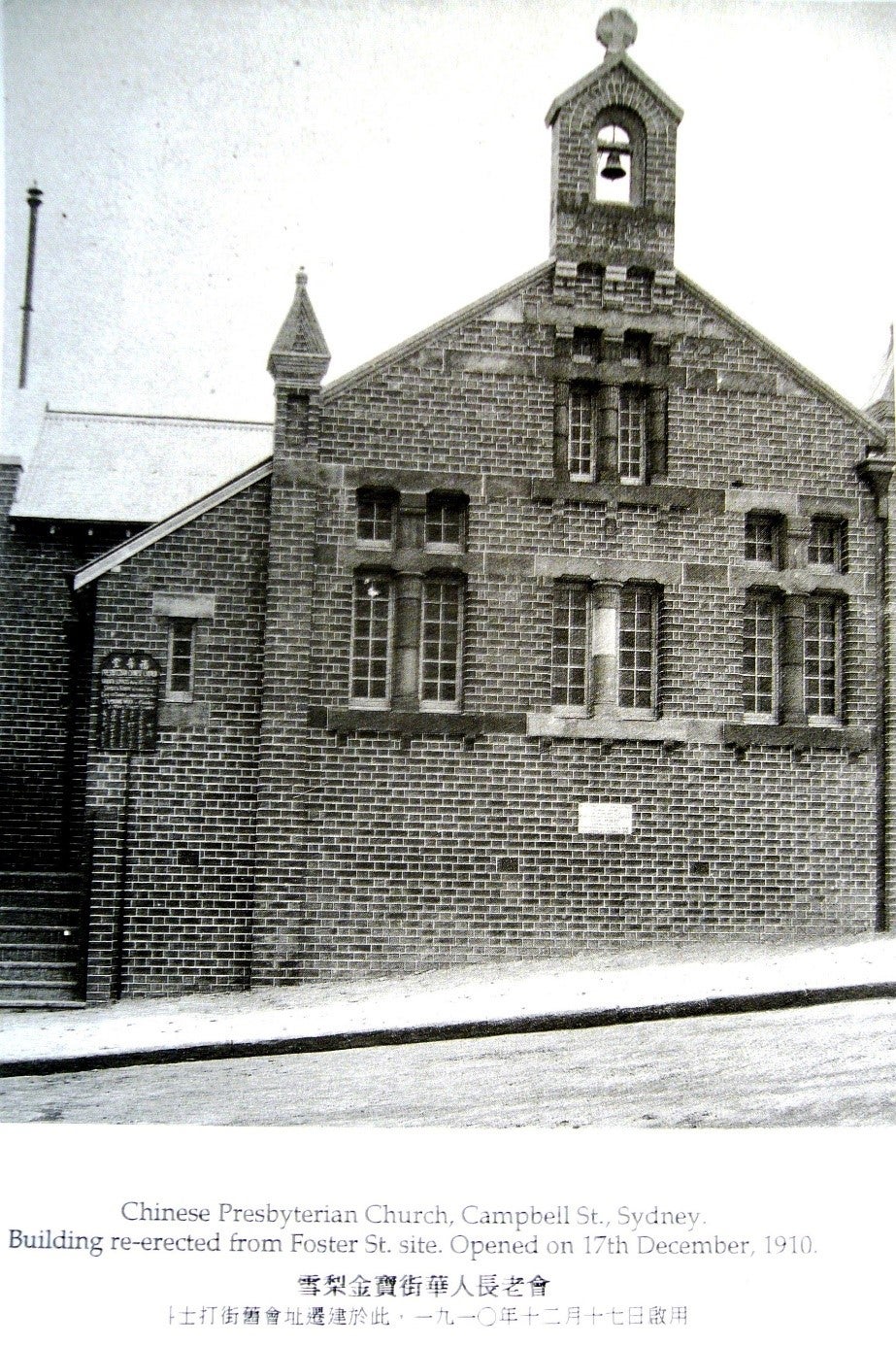
The Chinese Presbyterian Church, 108 Campbell Street (re-opened in 1910)

The CPC moved to Fullerton Memorial Church in Crown Street in 1957 (courtesy of Howard Wilson, 2009)
Liangdu Christian Church in Zhongshan 中山基督教良都堂 (founded 1918)
54, Shangtang West Street, South District, Zhongshan (中山南区上塘西街54号)
After becoming successful businessmen in Hong Kong, the Zhongshan migrants such as Ying Piu Ma, Wing Chan Ma, Lock Gock mentioned earlier (who were members of the Australian Chinese from the Chinese Presbyterian Church in Sydney) became involved in Presbyterian missionary work and in the building of churches in Hong Kong and Zhongshan.
Several of the founders of the Sincere and Wing On companies not only donated money to purchase land for the construction of the churches in Zhongshan but also acted as directors of the board of the ‘Heung Shan (Xiangshan) Presbyterian Self-governance Church’ (香山长老自理会). In around 1905, they purchased shares from the Sincere and Wing On companies for the churches and used the dividends of the shares to fund the operating expenses of the churches. Kindergartens and schools were also established in conjunction with the churches to provide education for the children in their homeland. The first church in Zhongshan, the ‘Taiping Christian Church’ (太平堂), founded by these returned migrants was opened in 1906 in Shekki (Zhongshan’s county town) and in 1928 moved to a bigger church in Taiping Road, Shekki. The church is still in use today.
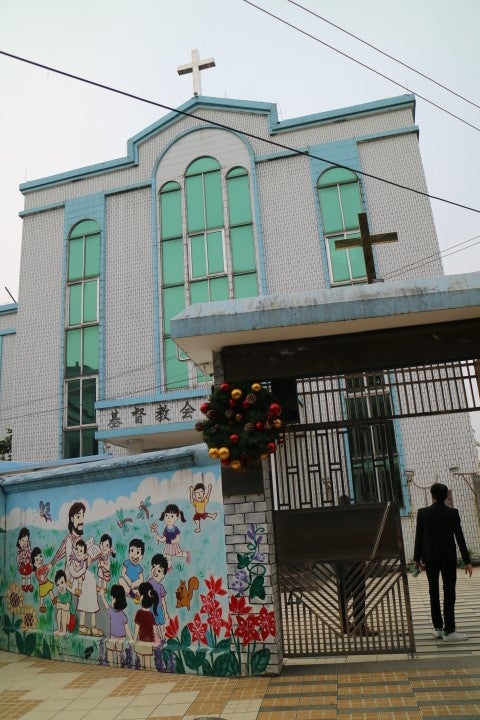
Liangdu Christian Church in South District (2017)
In 1918, a branch church, ‘Liangdu Christian Church’ (良都堂), was built in Shachong village in South District, the home village of these Australian Chinese. Outside the church, there is a stone plaque with the inscription recording that Wing Chan Ma laid the foundation stone on behalf of the board of directors in 1918. The church was built by a Hong Kong construction company at a cost of 26,000 Yuan. Many Australian Chinese, such as Ying Piu Ma, Wing Chan Ma, Chuen Gock, Hing Choy and other early directors of the Sincere and Wing On companies, were the major donors for the church.
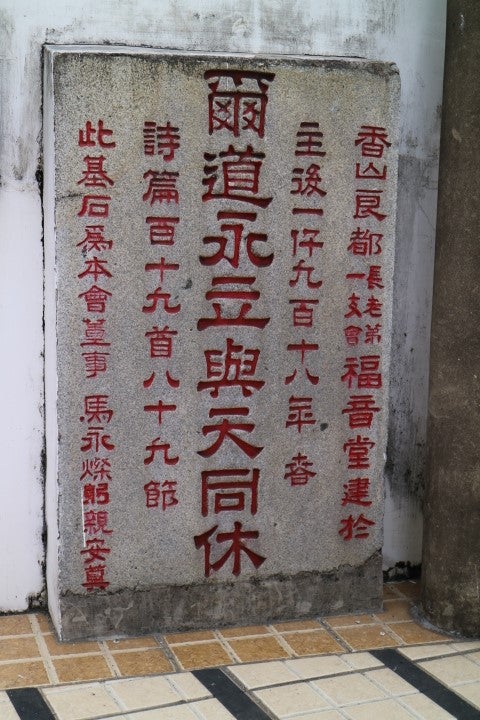
The foundation stone of Liangdu Christian Church. The inscription mentions that Wing Chan Ma laid the foundation stone on behalf of the board of directors in 1918
The church building has two floors. The ground floor was used as a school named 'Owe Lerng School' (歐亮學校) and the upper floor for worship. During the Cultural Revolution (1966-1976), the church ceased its services and was turned into a factory, services not being resumed till 1983. In 1997, the government of Zhongshan re-built the second floor of the church. Now the ground floor of the church is being used as a daycare centre, while the upper floor of the church, with the capacity of 350 people, is dedicated to worshipping. Liangdu Christian Church celebrated its centenary in 2018.
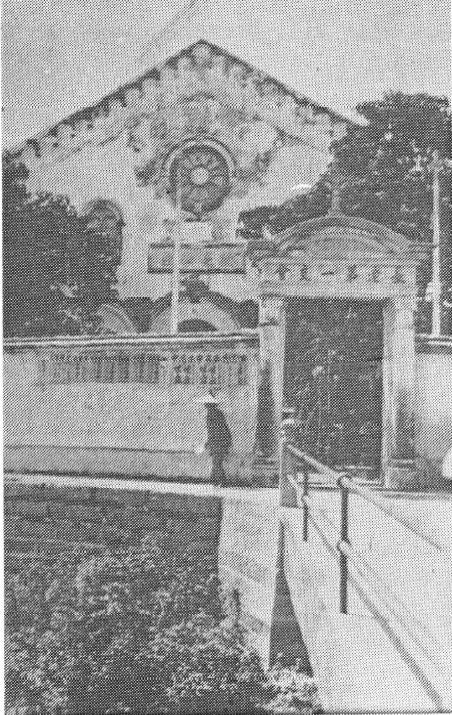
The original building of Liangdu Christian Church and Owe Lerng School (1924)
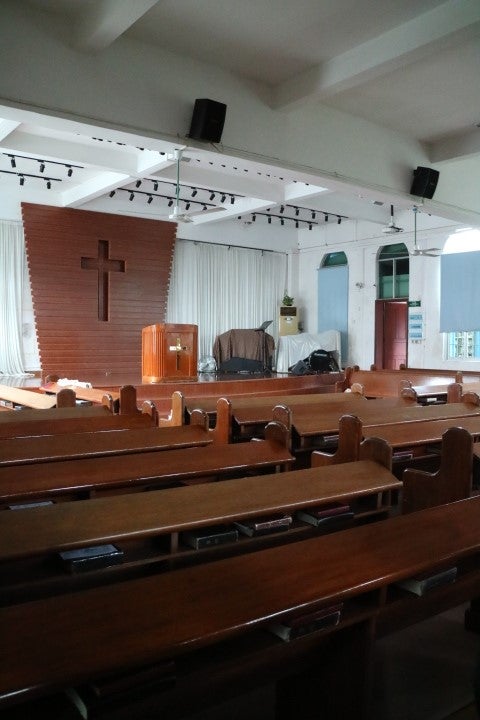
The second floor of Liangdu Christian Church. It can accommodate 350 people
Hop Yat Church (合一堂) Hong Kong (founded 1926)
2 Bonham Road, Mid-Levels, Hong Kong
Hop Yat Church in Hong Kong has a close connection to the Chinese Presbyterian Church of Australia via its association with Zhongshan men who had migrated to Australia in the late 19th century and later moved to Hong Kong. The history of Hop Yat Church can be traced back to the To Tsai Church (道濟會堂), which was founded by the London Missionary Society in 1888 and located at 75 Hollywood Road, in Hong Kong’s Mid-levels (半山區). In 1918, the London Missionary Society joined the Congregational Church and Presbyterian Church of China to form the Church of Christ in China (中华基督教会).

The construction of Hop Yat Church in 1925 (courtesy of Howard Wilson)
Due to the growth of the congregation, the Church of Christ in China decided to construct a new church building. In 1921, the London Missionary Society gave its former site on 2 Bonham Road to To Tsai Church for the construction of a new church. Members of To Tsai Church and Australian Chinese from the Presbyterian Church of Australia (including Ying Piu Ma, Wing Chan Ma, Chuen Gock and Hing Choy) raised money for the construction of the new church. The new church was completed in 1926 and named ‘Hop Yat’ (meaning ‘united as one’). It has maintained a close relationship with Tai Ping Church in Shekki, sharing many of the directors and ministers.
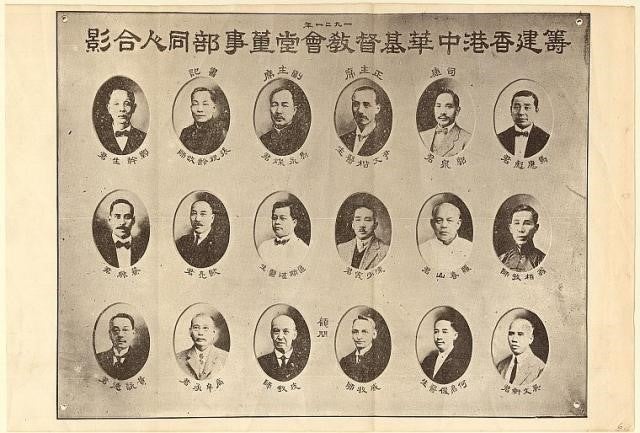
The photos of the directors of the fundraising committee to build a church for the Church of Christ in China. The 1921 committee included several Australian Chinese who were originally from the Chinese Presbyterian Church in Sydney (Ying Piu Ma, top row 1st from right; Chuen Gock, top row 2nd from right; Wing Chan Ma, vice-president, top row 3rd from left; Hing Choy, middle row 1st from left) (courtesy of Howard Wilson)
Hop Yat Church is in the neo-gothic architectural style and has a capacity of over 1500 people over its three levels. There is a large clock on the façade above the main entrance. After its opening, Hop Yat Church’s activities expanded rapidly, with missionary works extending to different places in Hong Kong where a number of schools were built. Hop Yat Church was damaged during the Japanese invasion of Hong Kong, but was renovated after the war. Branches of Hop Yat Church were built in Ho Man Tin in Kowloon (1961) and North Point on Hong Kong Island (1984). The church at Bonham Road has been classified as a Grade II historical building by the Hong Kong government.
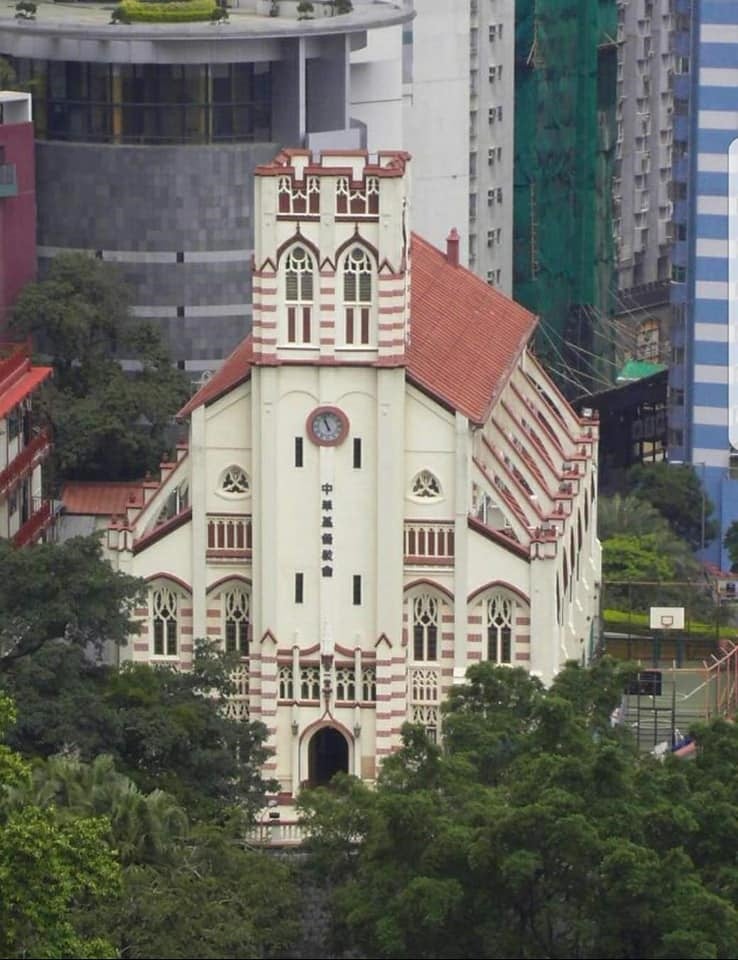
Hop Yat Church on 2 Bonham Road, Mid Levels, Hong Kong (courtesy of Howard Wilson)
Sources:
Kuo, M. F. (2013) Making Chinese Australia: Urban elites, newspapers and the formation of Chinese Australian identity, 1892-1912, Monash University Publishing.
Newspapers, historical photos and archival materials are collected by Mr Howard Wilson.
